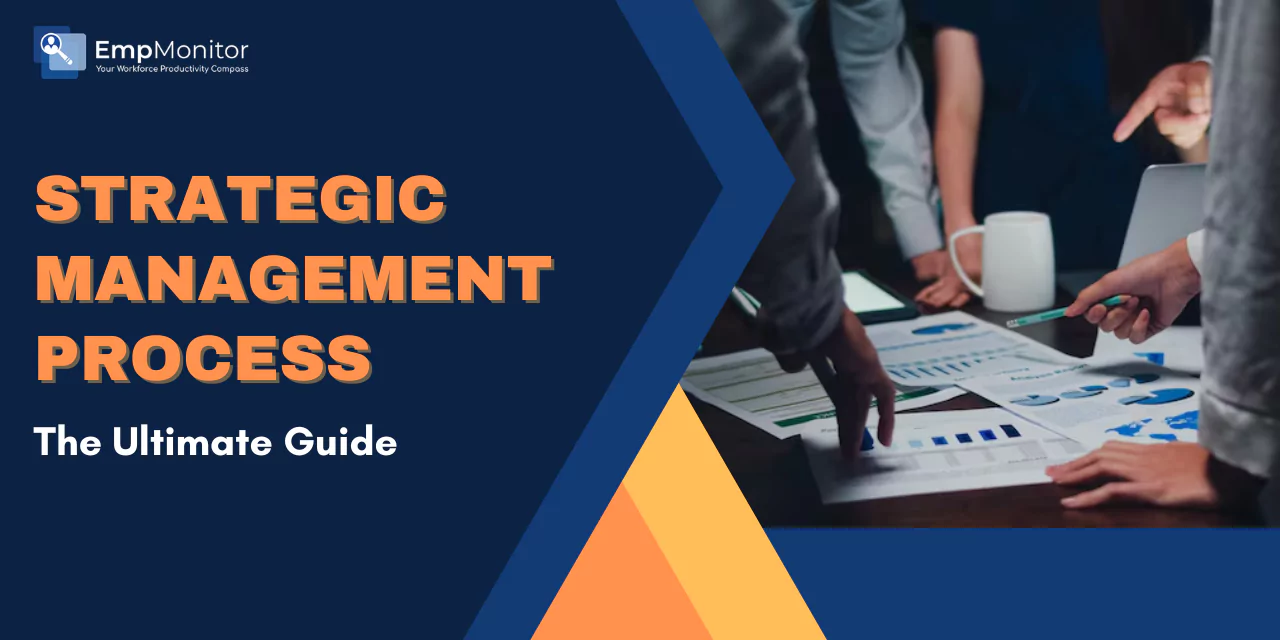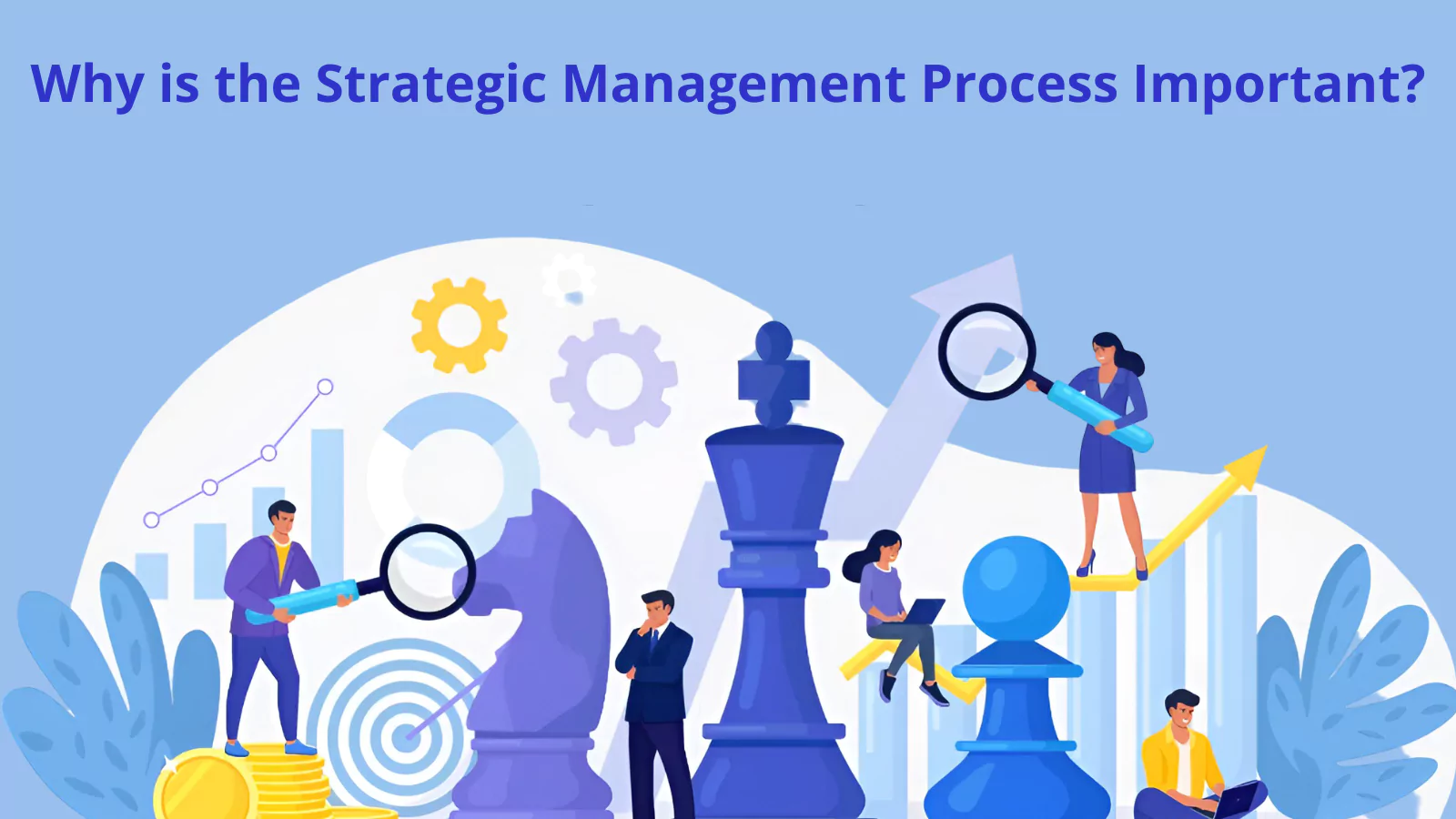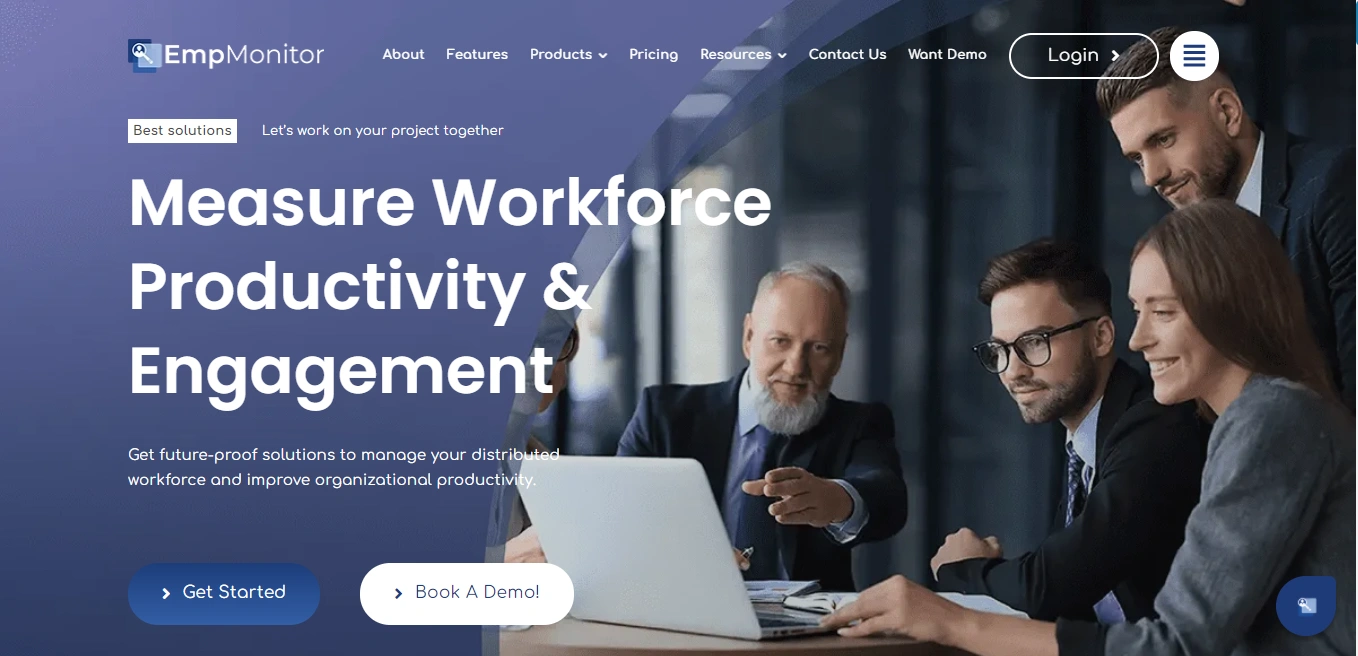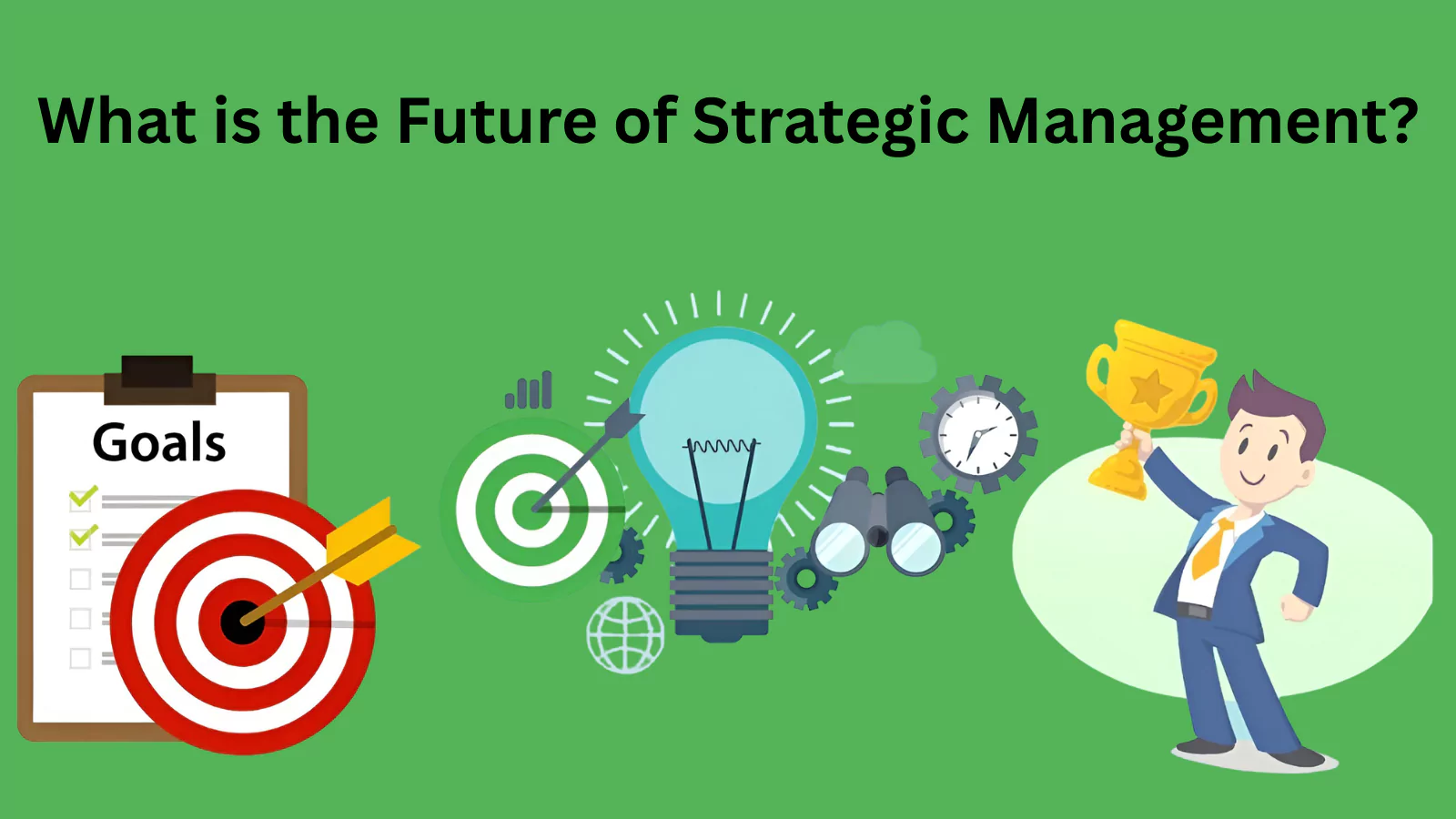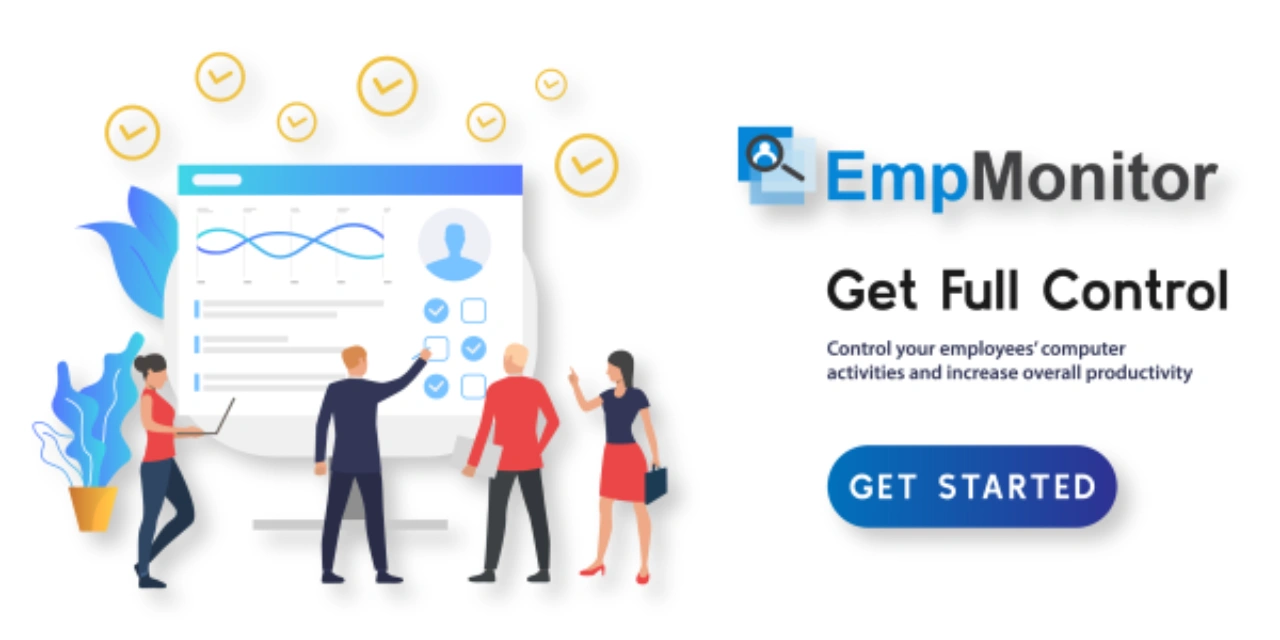Nowadays, organizations need more than just a good product or service to thrive; they need a clear strategy that guides every decision and action. At this point, the strategic management process becomes crucial, offering a roadmap for businesses to overcome obstacles, adjust to change, and seize new opportunities.
But what exactly is the strategic management process, and why is it crucial for success? Simply put, it’s the series of steps that leaders take to define, implement, and refine their business strategy over time. From setting long-term goals to adjusting tactics based on real-time feedback, this process keeps an organization on course, ensuring it remains competitive and aligned with its vision.
In this blog, we’ll explore strategic management, why it matters, and how a well-executed process can make all the difference in achieving sustainable growth.
In a rush? This podcast delivers the essentials.
What is the Strategic Management Process?

The strategic management process refers to the method by which organizations define their strategy, allocate resources, and implement plans to achieve long-term objectives. It is a continuous cycle involving analysis, decision-making, and execution that ensures businesses remain aligned with their mission and competitive in the marketplace.
Unlike ad-hoc decision-making, the strategic management process is systematic and data-driven. It incorporates both internal and external factors, allowing businesses to adapt and evolve as conditions change.
Steps of the Strategic Management Process
Understanding the key components of the strategic management process is crucial. Here are the five major steps involved:
Step 1: Defining the Mission and Objectives
The organization’s mission, vision, and objectives are at the core of the strategic management process. These elements provide direction and set the tone for all future strategies.
A well-crafted mission statement defines the purpose of the organization, while specific objectives break down long-term goals into measurable outcomes. Clarity in this step is vital for the alignment of all subsequent strategies.
Step 2: Environmental Scanning and Analysis
This step involves a thorough analysis of both internal and external environments. Tools like SWOT (Strengths, Weaknesses, Opportunities, Threats) analysis are often used.
External analysis includes studying market trends, competitors, and macroeconomic factors. Internal analysis involves assessing company resources, capabilities, and overall performance. This data forms the foundation for informed strategic planning within the strategic management process.
Step 3: Strategy Formulation
After analyzing the environment, the next phase in the strategic management process is strategy formulation. This includes identifying the best course of action to achieve organizational goals.
Companies may choose among various strategies such as cost leadership, differentiation, or market penetration. The selected strategy must align with the organization’s mission and available resources.
Step 4: Strategy Implementation
After developing a strategy, the focus shifts to its execution. This part of the strategic management process focuses on resource allocation, task delegation, and managing ongoing activities.
Effective strategy implementation requires collaboration across departments, clear communication, and the right technological support. Platforms like EmpMonitor play a crucial role in this stage by offering real-time workforce insights, productivity tracking, and streamlined task management, ensuring that your strategy is executed efficiently and aligned with organizational goals.
Step 5: Strategy Evaluation and Control
The final stage of the strategic management process involves monitoring outcomes, comparing them with set objectives, and making necessary adjustments.
Performance metrics and key performance indicators (KPIs) are used to evaluate success. This step ensures that the strategy remains effective and relevant, adapting to internal shifts or external market changes.
Read more :
05 Best Strategies for Implementing Successful Workforce Planning
06 Best Ways to Improve Employee Retention
Why is the Strategic Management Process Important?
It’s the foundation that helps organizations stay focused, aligned, and prepared for uncertainty. Without it, even the best ideas can lose direction. With a clear process in place, leaders can make informed decisions faster, respond more effectively to change, and keep the entire team moving in the same direction.
By following a systematic approach, businesses can:
1. Align resources effectively with organizational goals.
When teams know the “why” behind their efforts, resources, whether time, money, or talent, are used wisely and with purpose, reducing waste and boosting impact.
2. Proactively respond to market changes.
Instead of reacting to disruption, companies become anticipators, spotting trends early and shifting strategies before challenges escalate.
3. Foster innovation and continuous improvement.
A strong strategy framework encourages experimentation and feedback, helping teams refine what works and explore new possibilities with confidence.
4. Minimize risks and maximize returns
With clearer visibility into opportunities and threats, businesses can make smarter moves, avoiding pitfalls while capitalizing on growth potential.
At its core, the strategic workforce planning process connects strategy formulation with implementation, enhancing the chances of sustained success over time.
Strategic Management vs Operational Management
While the strategic management process focuses on long-term vision and direction, operational management deals with day-to-day activities. Understanding the distinction between the two is essential:
1. Focus & Scope
-
Strategic Management:
Strategic management is primarily focused on defining the future path of the organization. It addresses questions like Where do we want to be in 5 or 10 years?, What markets should we enter?, and How do we remain competitive in the long run? This includes analyzing the external environment, anticipating industry shifts, and aligning internal capabilities to long-term opportunities. -
Operational Management:
Operational management ensures that the day-to-day activities are aligned with the strategic plan. It’s about optimizing internal processes, managing personnel, maintaining quality, and ensuring that the organization runs smoothly. This level of management transforms strategic direction into tangible actions and results.
2. Time Horizon
-
Strategic:
Strategic planning typically spans a longer time frame, usually between 3 to 10 years, though in some sectors, it may stretch further. It focuses on foresight, trend analysis, and preparing the organization for sustained success over time. -
Operational:
Operational planning deals with immediate and near-term goals what needs to be accomplished today, this week, this month, or this quarter. It includes detailed schedules, task assignments, and performance tracking over short intervals.
3. Nature of Decisions
-
Strategic:
Decisions at this level are transformational. They may involve large investments, expansion into new markets, or shifts in the business model. These decisions are uncertain and risky, but they define the company’s long-term survival and competitiveness. -
Operational:
These are transactional decisions, such as scheduling staff shifts, restocking inventory, or resolving customer service issues. They are typically repetitive and data-driven, aimed at maintaining continuity and efficiency.
4. Goals and Objectives
-
Strategic:
The goals here are broad, visionary, and directional. Examples include becoming an industry leader, achieving sustainability milestones, or launching innovative products. These goals provide a framework for all organizational efforts. -
Operational:
Objectives are specific, measurable, and actionable. For instance, increasing production output by 10% this quarter or reducing customer service response time to under 2 minutes. These feed directly into strategic goals.
5. Flexibility vs. Structure
-
Strategic:
Strategy must remain flexible and adaptable, allowing the organization to pivot in response to external shifts like technological disruption, market changes, or global events. A good strategy evolves with new data and insights. -
Operational:
Operations thrive on consistency and structure. Standard operating procedures (SOPs), rules, and protocols are in place to minimize variability and maximize efficiency. Flexibility exists but is usually limited to fine-tuning existing processes.
What are the Challenges in Strategic Management?
Implementing the strategic management process is not without its challenges. Common obstacles include:
-
Resistance to change from employees.
Adjusting to change can be challenging, particularly when it interferes with established habits. Engaging employees early, listening to their concerns, and showing them the benefits of change can ease the transition and build trust.
-
Poor communication between departments.
When teams don’t share information openly, it’s easy for confusion and duplication to creep in. Encouraging cross-functional collaboration and regular updates helps everyone stay on the same page.
-
Lack of resources or unclear goals.
Without a clear direction or the tools to act on it, even the most motivated teams can struggle. Leaders must prioritize setting focused, realistic goals and allocating resources where they matter most.
-
Rapid market changes disrupting strategies.
Markets change rapidly, and strategies that were effective in the past might become obsolete in the future. Staying alert, encouraging agility, and having contingency plans can help businesses pivot with confidence when the unexpected happens.
To overcome these, businesses should foster a culture of adaptability, ensure transparent communication, and regularly revisit their strategic plans.
What Is The Role of Technology in the Strategic Management Process?

Technology has become a powerful catalyst in shaping and driving strategic management. It not only supports better decision-making but also transforms how organizations operate and compete. From leveraging data analytics for actionable insights to automating repetitive processes, modern tools empower leaders to respond swiftly and strategically in real time.
Innovative solutions such as business intelligence platforms and workforce management system enable companies to monitor performance, anticipate market shifts, and manage their teams with greater efficiency. By integrating these technologies into everyday operations, businesses can align their goals, optimize resources, and foster a more agile, informed, and future-ready workforce.
How To Empower Strategy With Workforce Tools?
In today’s dynamic work environment, aligning your workforce with strategic goals is more critical than ever. Tools like EmpMonitor play a vital role in supporting the strategic management process by offering clear insights into employee performance and behavior.
EmpMonitor comes equipped with powerful features such as:
1. Time Tracking
Gain a clear understanding of how your employees manage their time during work hours. Easily detect work patterns and highlight top performers with the help of automated reporting. Utilize intuitive real-time timesheets that display activity metrics, helping you boost overall productivity with smarter time management.
2. Workforce Productivity & Engagement
Unlock a powerful suite of tools designed to support every aspect of workforce operations. Boost employee performance and engagement through advanced HR intelligence, streamlined project management, and detailed time-tracking insights, all built to enhance productivity while simplifying administrative tasks.
3. Project Management
Simplify your project workflows with easy task assignment and seamless team collaboration. Keep track of progress with detailed timelines and time reports, giving you clear insights into productivity and resource use, helping your team stay on course and deliver results efficiently.
4. Effortlessly Enhance Employee Management Tasks
Discover an all-in-one toolkit designed to support every aspect of workforce operations, offering end-to-end solutions for smooth and efficient employee management.
By leveraging EmpMonitor, organizations gain more than just oversight, they build a transparent and accountable workplace. With better visibility into team dynamics and workflows, leaders can make smarter, faster decisions that directly support strategic goals and long-term growth.
Integrating Employee Management for Strategic Success
Employee engagement and performance are integral to the success of any strategy. Tools that streamline employee management software functions, such as task allocation, attendance, and appraisal, contribute directly to the success of the strategic management process.
When employees understand how their roles align with organizational goals, their performance improves, leading to more successful strategy implementation.
Empowerment of Strategic Human Resource Management
A significant part of the strategic management process involves aligning HR practices with business objectives, known as strategic human resource management. This encompasses staffing strategies, employee retention process , growth initiatives, and overseeing performance outcomes.
Modern HR strategies, backed by analytics and automation tools like EmpMonitor, enable businesses to make informed decisions, optimize talent utilization, and support overall strategic goals.
What Is The Future Of Strategic Management?
The strategic management process is evolving. Trends like AI, remote work, and globalization are changing how strategies are formulated and implemented.
Future-ready strategies will be:
-
Data-driven.
Decisions based on intuition are giving way to those backed by real-time insights. Leveraging analytics helps businesses identify trends early, track performance closely, and make smarter, faster choices.
-
Flexible and adaptive.
Rigid plans don’t survive in unpredictable environments. Successful strategies must evolve as new challenges arise, allowing businesses to pivot quickly without losing sight of their core goals.
-
Integrated with real-time monitoring tools.
Organizations that embrace innovation in their strategic management process will be better equipped to navigate the complexities of the modern business world.
Final Thoughts
Mastering the strategic management process is key to achieving lasting success in today’s fast-paced business environment. From crafting a clear, purposeful mission to embracing cutting-edge technologies, every step you take plays a vital role in shaping a resilient and competitive organization.
Tools like EmpMonitor are invaluable in optimizing workforce management, enhancing HR strategies, and ensuring your company remains on track for sustainable growth. These platforms not only simplify day-to-day operations but also provide actionable insights that drive smarter decision-making.
As organizations continue to evolve, the strategic management process will always be the bedrock of strong leadership and organizational excellence. It’s the framework that guides businesses through change, helping them adapt and thrive in an increasingly dynamic market.
FAQs
Q1: What is strategic management?
A: Strategic management is the process of setting long-term goals, analyzing competitive environments, and implementing plans to achieve organizational success.
Q2: Why is the strategic management process important?
Ans: It aligns resources, improves decision-making, enhances adaptability, and increases the chances of achieving long-term objectives.
Q3: How does EmpMonitor support the strategic management process?
Ans: EmpMonitor provides tools for workforce analytics, employee monitoring, and task management that enhance strategy execution.
Q4: Can strategic and operational management coexist?
Ans: Yes, while they serve different purposes, they are complementary. Operational management executes the strategic vision.
Q5: What are the latest trends in the strategic management process?
Ans: Integration of AI, use of predictive analytics, real-time monitoring, and cloud-based collaboration tools.

